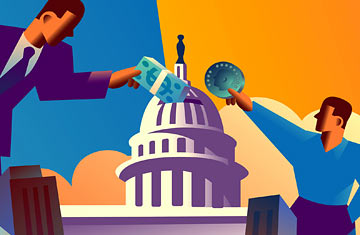
There may well be green shoots in the economy, but American consumers are still withering. That was the message from the Census Bureau's retail sales report on Wednesday morning, with sales dropping 0.4% overall in April. Forecasters had expected no change.
It's worth pointing out that this difference was within the survey's margin of error. That is, the decline could just be noise. But other news in the report — and evidence from other sources — points to a consumer-spending trend that is at best flat. Retail sales excluding automobiles, a better indicator of the underlying trend, were down 0.5%. March's overall sales decline was revised down to 1.3% from 1.2%. And so on. (See the top 10 financial collapses of 2008.)
None of this means that the recent talk of a turn in the economy is necessarily nonsense. It's just an indication that consumer spending, typically a driver of economic upturns, may well be a drag this time. Personal-consumption expenditures as measured by the Commerce Department's Bureau of Economic Analysis had grown to more than 70% of gross domestic product (GDP) in recent years, well above the 1950s-1990s average of 64%. This was an artifact of the consumer and mortgage credit boom of the 2000s, and economists ranging from Morgan Stanley's Stephen Roach to White House economic czar Larry Summers had been proclaiming for several years that the percentage had to come down. It has thus far stubbornly refused, with consumer spending hitting 70.7% of GDP — close to a record — in the first quarter of this year. American households have lost too much wealth and the job market is too miserable for that to keep up much longer.
As a result, the best-case scenario for an economic recovery is one in which the consumer's share of economic activity shrinks, but gains in other sectors are enough to keep the economy growing at least modestly. In GDP lingo, those other sectors are government-consumption expenditures, gross private domestic investment (business plus housing) and net exports. Let's run through them:
Government spending is the easiest to predict. With only 6% of the $787 billion stimulus package disbursed thus far, there's a lot of spending on the way in the next year and a half. After that, pressure from buyers of Treasury securities will probably force a return to fiscal discipline. But over the short run, government should provide a big boost.
Business investment fell at a staggering 38% annual rate in the first quarter — the worst such performance since the government began keeping quarterly records in 1947. That can't go on forever, and much of the recent talk of green shoots has to do with indications that business spending is at least starting to stabilize. Investment in housing was also down 38%, the sharpest drop since 1980, and there, too, optimists have found early signs of stabilization. It's not unreasonable to think that, sometime in the next few quarters or even months, business and housing will stop dragging the economy down and begin to provide at least a modest boost. (See pictures of retailers that have gone out of business.)
But it's a complicated equation — in laying off workers by the millions, corporate America may have cut costs and cleared the way for future profits and investment, but it has also reduced the number of consumers able to do any spending. Similarly, the current death throes of the housing market may prefigure an eventual rebirth, but in the meantime, falling prices and rising foreclosures are still wreaking havoc with consumer finances. More troubles for consumers could lead to renewed troubles for business and in housing, meaning there are feedback loops at work here that no economic forecast can fully capture.
Which leaves net exports. The last time the U.S. actually exported more goods and services than it imported was in 1980, and a positive trade balance isn't in the cards anytime soon. But if U.S. consumer spending remains anemic, a rebound overseas could shrink the trade deficit and thus boost the economy. There's just no concrete evidence of that happening yet — the March trade figures, released on Tuesday, showed exports declining faster than imports for the month. Over the somewhat longer term, the big question is whether the global economy can be rebalanced in a way so that the likes of China, Korea, Japan and Germany don't run such big trade surpluses and the U.S. doesn't run such big deficits. Without such a shift, it's hard to see how the U.S. can put together a strong, sustainable recovery.
